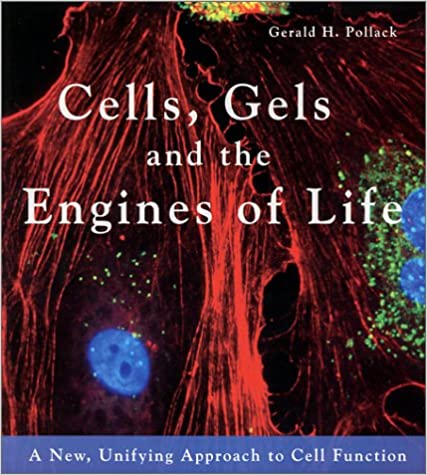Gerald H. Pollack
Cells, Gels and the Engines of Life by Gerald H. Pollack | modern cell theory
Cells, Gels and the Engines of Life by Gerald H. Pollack | modern cell theory
Couldn't load pickup availability
Introducing a fresh perspective on cellular function, "Cells, Gels, and the Engines of Life" unveils a modern cell theory that revolutionizes our understanding of how cells operate. This book delves into the intricate workings of cells, questioning established notions and offering a simplified approach to fundamental processes like movement, transport, division, and communication. Grounded in sound physical principles, the book is richly illustrated with vibrant color figures, ensuring clarity for both experts and non-experts. Written in an accessible and often humorous style, it provides a captivating journey into the fascinating world of cells, challenging conventional wisdom and introducing a modern paradigm that will reshape your comprehension of cellular mechanisms.
100% MONEY BACK GUARANTEE: If you are not satisfied with your purchase you can return or replace this item within 30 days of delivery.
Note: The "Buy on Amazon" button link provided is an affiliate link. As an Amazon Associate, we may earn from qualifying purchases. Rest assured, using this link doesn't impact the product cost for you. Your satisfaction is our priority, and we appreciate your understanding and support.
Share

This book is heretical and courageous, and - if it can escape burning - may become a seminal landmark in our understanding of living systems. Based to a large extent on the pioneering (and often unfairly derided) work of Gilbert Ling, the book focuses on the importance of the gel-like nature of living cytoplasm - the interior of living cells - at the expense of the vaunted cell membrane. It turns out that cells can do fairly well without intact cell membranes because many functions attributed to the membrane are actually accomplished by gel properties of sub-membrane cytoskeleton of actin, microtubules and other protein structures. Pollack provides evidence that patch clamp techniques, which claim to study isolated membranes (and have provided much of the "evidence" for membrane ion channel and ion pumping mechanisms) include sub-membrane actin cytoskeleton which, according to Pollack, is actually regulating ionic fluxes and concentrations.
The book describes how cytoplasmic gels manifest collective phase transitions such as polymerization of actin proteins with accompanying ordering of cell water and exclusion of large cations. According to Pollack, these collective phase transitions can explain not only ionic fluxes, but also voltage gradients, propagating action potentials, mitosis, muscle contraction and cell movement. Ion channels and pumps are not mythical, but overstated. Pollack traces the roots of (in his view) the "membrane-centric" misconceptions and his proposed revolution is believable. Our cells are not bags of liquid governed by membrane activities, but protein matrix-based gels covered by a thin semi-permeable membrane "skin". The cytoplasm is intrinsically reactive and able to maintain cell homeostasis and functions. The cytoplasmic gel best captures the essence of the living state.
Molecular biologists, biochemists, membrane physiologists and others will no doubt gnash their teeth over this book, and many will dismiss it out of hand, citing ever-expanding knowledge in their respective fields. However ultrareductionist "bind and grind" techniques quite often fail to see the forest for the trees. Pollack encourages readers to compare his ideas to conventional approaches as espoused in mainstream textbooks. Any objective biologist should do so.
The book is easy to read, clear and understandable, and well illustrated with simple diagrams. Those willing to curb their dogma will find it stimulating and delightful.
Whew. I think this is probably correct as the biology models were just too orderly. So much organization in such small structure! Or is that structure a tattoo on a different reality which is much deeper.
If I had to guess, my guess is that this is correct. If not, it at least saved me from seeing everything everywhere all at once...
The most engaging science books tackle the narratives that scientists believe and on which they base study designs and interpretations. This book provides a detailed case study of how such scientific stories and simple mental images operate to guide entire fields over decades - and not always along the best available paths. This book questions a whole list of "textbook" fundamentals and offers an alternative, integrated framework for explaining a wide range of cell functions. Once a misguided view has been established in any field, it can take a rare blend of courage, expertise, and clarity to budge things in a new direction.
Anyone with a firm reading ability can delve into this book and might be surprised, given the school-inflicted association of basic science instruction with soporific textbooks, to be sucked in on the first page. This is much more than a book about how cells work; it is a master class in fresh and precise scientific thinking, an art much in need of renaissance in an age of truth by click-through count, research-grant total, and mere widespread assertion.
Pollack starts by peeling back layers of decaying assumptions about the functionality of the living cell, showing how each narrative twist was constructed to salvage some older assumption that was in danger of withering before new evidence. A cell "wall" was originally imagined long ago as being needed to keep the cytoplasmic "aqueous solution" within the cell; otherwise, the cytoplasm would surely dissipate into its surroundings.
Eventually, though, a long series of problems with that story began to emerge. But instead of killing the story, each new problem elicited a patch to salvage the old model. First, certain ions had to move into and out of the cell. So to get ions moving in, some "channels" through this "wall" had to be postulated. Then, to get them moving out again, we needed some "conveyers."
Researchers gradually discovered more and more substances of myriad shapes and sizes moving into and out of cells in an epic dance. Many of these substances were also staying either inside or outside in precise ratios. The "channels" and "conveyers" that would be needed to make all of this happen started to multiply beyond the wildest nightmares of a factory-automation engineer. Moreover, the energy that would be required to keep all of these imagined mechanisms running seemed to far exceed the available supply.
Pollack likens this situation to the crisis of the old geocentric model of the solar system, the one that tried to explain the impossible, winding orbits of planets around the Earth. As it turned out, of course, those orbits appeared so wildly intricate because they weren't orbits around the Earth at all. Likewise, according to Pollack, the mind-boggling complexity of conventional cellular channels and conveyers has become the crisis of the old story of how cells work. He makes a detailed case that this old picture is misdirected at virtually every step and should be updated by looking with fresh eyes at newly available research while revisiting some older views that were trampled under and mostly lost in the march of scientific "progress."
A major source of challenge for the old story, with its central role for the cell wall, is a broad pattern of experimental results in which cell membranes are destroyed or removed and ... nothing much happens (at least not for hours or days). This makes it clear that something else is also at work, but what?
Pollack outlines a new model that begins with the fundamentals of how proteins, water, and ions interact at a chemical level. By this time, he has posed some other puzzling questions about cells. Among them, why do they only freeze at temperatures much colder than expected based on their chemical composition alone?
It turns out that the cytoplasm is no "aqueous solution" at all, Pollack argues. However, the idea that it is, first made well over a century ago, set the entire field down a misleading path. Instead, cytoplasm is a gel, and one of the long-missing pieces of the cytoplasmic-gel puzzle is structured water (watch his University of Washington Annual Faculty Lecture on structured water). Pollack argues that much of the water within cells is not mere "bulk water" (random molecules in liquid state). Rather, water can structure itself into an ordered grid that builds on charge patterns on protein surfaces. Cytoplasm is infused with a fine interior latticework, the surface area of which amounts to 100 times the surface area of the cell membrane. Structured water lines up along these internal lattice surfaces. This is far from the conventional view of an intracellular solution in perilous need of being held in by a retaining wall.
Pollack identifies structured water as a fourth state of matter between normal liquid water and solid ice. Structured water helps explain the odd resistance of cells to freezing. Water molecules are dipolar and can arrange themselves in grids with v...

